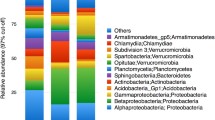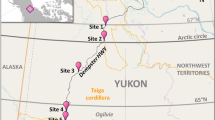Abstract
Critical transition zones, such as aquatic–terrestrial interfaces, have been recognized as important features in landscape ecology. Yet changes in the community structure of soil and sediment biota across aquatic–terrestrial boundaries remain relatively unstudied. We investigated the community structure of the dominant fauna, namely nematodes, rotifers and tardigrades, across lake sediment–soil transects in three basins in a species-poor, polar desert ecosystem (McMurdo Dry Valleys, Antarctica). We also examined substrate (that is, soil and sediment) properties, including moisture, salinity, carbon, nitrogen and phosphate concentration, across these transects. Differences in faunal community structure and biochemical properties were typically explained by hydrologic basin and the sediment–soil gradient, but not by transects within each basin. Bonney Basin contained the least organic carbon, chlorophyll a, nematodes and taxa, whereas there was little difference in many of these measures between Fryxell and Hoare Basins. Nematode (Scottnema lindsayae and Plectus sp.) and rotifer abundance varied along sediment–soil transects. Scottnema lindsayae, the most abundant and widely distributed soil animal in this ecosystem, increased in abundance from sediments to soils, whereas Plectus sp. and rotifer abundance, and taxa richness (that is, nematodes, rotifers and/or tardigrades), decreased; Eudorylaimus sp. and tardigrade abundance did not differ significantly along the transects. Previous studies of soil biodiversity and faunal abundance in this ecosystem have revealed a positive association between these measures and biogeochemistry, if this holds true for lake sediments, our findings suggest sediments in Lake Bonney experience lower rates of nutrient cycling than either Lakes Fryxell or Hoare. Despite differences in faunal abundances along the sediment–soil transects, taxa occurrence was surprisingly similar in soil and sediment, only S. lindsayae was restricted to soil or the lake shore. In contrast, in other ecosystems, soil community composition differs greatly from lake sediments, suggesting that the observed similarity in species occurrence in both soils and sediments may be unique to Antarctica. This finding might result from the extreme low diversity of this ecosystem, presumably limiting competition among fauna, and thus promoting broad ecological niches. Alternatively, environmental conditions in Antarctica may select for species with broad ecological niches.







Similar content being viewed by others
REFERENCES
Adams BJ, Bardgett RD, Ayres E, Wall DH, Aislabie J, Bamforth S, Bargagli R, Cary C, Cavacini P, Connell L, Convey P, Fell JW, Frati F, Hogg IH, Newsham KK, O’Donnell A, Russell N, Seppelt RD, Stevens MI 2006. Diversity and distribution of Victoria Land biota. Soil Biol Biochem 10:3003–18
Andrassy I. 1998. Nematodes in the sixth continent. J Nematode Morphol System 1:107–86
Ayres E, Wall DH, Bardgett RD. 2007. Trophic interactions and their implications for soil C fluxes. Bahn M, Heinemeyer A, Kutsch W, Eds. Integrated methodology on soil carbon flux measurements. Cambridge, UK: Cambridge University Press. (in press)
Bardgett RD. 2005. The biology of soil: A community and ecosystem approach. Oxford, UK: Oxford University Press
Bardgett RD, Anderson JM, Behan-Pelletier V, Brussaard L, Coleman DC, Ettema C, Moldenke A, Schimel JP, Wall DH 2001. The influence of soil biodiversity on the hydrological pathways and the transfer of materials between terrestrial and aquatic ecosystems. Ecosystems 4:421–9
Barrett JE, Virginia RA, Wall DH 2002. Trends in resin and KCl-extractable soil nitrogen across landscape gradients in Taylor Valley, Antarctica. Ecosystems 5:289–99
Barrett JE, Virginia RA, Wall DH, Parsons AN, Powers LE, Burkins BB 2004. Variation in biogeochemistry and soil biodiversity across spatial scales in a polar desert ecosystem. Ecology 85:3105–18
Barrett JE, Virginia RA, Hopkins DW, Aislabie J, Bargagli R, Bockheim JG, Campbell IB, Lyons WB, Moorhead D, Nkem J, Sletten R, Steltzer H, Wall DW, Wallenstein M 2006. Terrestrial ecosystem processes of Victoria Land, Antarctica. Soil Biol Biochem 38:3019–34
Barrett JE, Virginia RA, Wall DH, Cary SC, Adams BJ, Hacker AL, Aislabie JM. 2006. Covariation in soil biodiversity and biogeochemistry in Northern and Southern Victoria Land, Antarctica. Antarc Sci 18:535–548
Bøhn T, Amundsen P-A 2004. Ecological interactions and evolution: forgotten parts of biodiversity? BioScience 54:804–5
Campbell IB, Claridge GG 1987. Antarctica: soils, weathering processes and environment. Developments in soil science, vol 16, Amsterdam: Elsevier
Clow GD, McKay CP, Simmons GM, Wharton RA 1988. Climatological observations and predicted sublimation rates at Lake Hoare, Antarctica. J Clim 1:715–28
Courtright EM, Wall DH, Virginia RA 2001. Determining habitat suitability in an extreme environment: the McMurdo Dry Valleys, Antarctica. Antarct Sci 13:9–17
Doran PT, McKay CP, Clow GD, Dana GL, Fountain AG, Nylen T, Lyons WB 2002a. Valley floor climate observations from the McMurdo dry valleys, Antarctica. J Geophys Res 107:4772–84
Doran PT, Priscu JC, Lyons WB, Walsh JE, Fountain AG, McKnight DM, Moorhead DL, Virginia RA, Wall DH, Clow GD, Fritsen CH, McKay CP, Parsons AN 2002b. Antarctic climate cooling and terrestrial ecosystem response. Nature 415:517–20
Foreman CM, Wolf CF, Priscu JC 2004. Impact of episodic warming events on physical, chemical and biological relationships of lakes in the McMurdo Dry Valleys, Antarctica. Aquatic Geochem 10:239–68
Fountain AG, Lyons WB, Burkins MB, Dana GL, Doran PT, Lewis KJ, McKnight DM, Moorhead DL, Parsons AN, Priscu JC, Wall DH 1999. Physical controls on the Taylor Valley ecosystem, Antarctica. BioScience 49:961–71
Freckman DW, Virginia RA 1993. Extraction of nematodes from Dry Valley Antarctic soils. Polar Biol 13:483–7
Freckman DW, Virginia RA 1997. Low-diversity Antarctic soil nematode communities: Distribution and response to disturbance. Ecology 78:363–9
Freckman DW, Virginia RA. 1998. Soil biodiversity and community structure in the McMurdo Dry Valleys, Antarctica. Priscu JC, Ed. Ecosystem dynamics in a polar desert: The McMurdo Dry Valleys, Antarctica. Washington DC: American Geophysical Union. pp 323–35
Freckman DW, Blackburn TH, Brussaard L, Hutchings P, Palmer MA, Snelgrove PVR. 2001. Linking biodiversity and ecosystem functioning of soils and sediments. Ambio 26:556–62
Frenot Y, Chown SL, Whinam J, Selkirk M, Convey P, Skotnicki M, Bergstrom DM. 2005. Biological invasions in the Antarctic: extent, impacts and implications. Biol Rev 80:45–72
Goodey T. 1963. Soil and freshwater nematodes. London: Butler and Tanner
Groffman PM, Bohlen J 1999. Soil and sediment biodiversity: Cross-system comparisons and large-scale effects. BioScience 49:139–48
Heemsbergen DA, Berg MP, Loreau M, Van Hal JR, Faber JH, Verhoef HA 2004. Biodiversity effects on soil processes explained by interspecific functional dissimilarity. Science 306:1019–20
Keeney DR, Nelson DW 1982. Nitrogen — inorganic forms. Page AL, Miller RH, Keeney DR, Eds. Methods of soil analysis: Part 2 Chemical and microbiological properties. Madison, WI: American Society of Agronomy, Soil Science Society of America. pp 643–98
Liiri M, Setälä H, Haimi J, Pennanen T, Fritze H 2002. Relationship between soil microarthropod species diversity and plant growth does not change when the system is disturbed. Oikos 96:137–149
Lizotte MP, Priscu JC. 1998. Pigment analysis of the distribution, succession, and fate of phytoplankton in the McMurdo Dry Valley lakes of Antarctica. Priscu JC, Ed. Ecosystem dynamics in a polar desert: The McMurdo Dry Valleys, Antarctica. Washington DC: American Geophysical Union. pp 229–39
McCain ME, Boyer EW, Dent CL, Gergel SE, Grimm NB, Groffman PM, Hart SC, Harvey JW, Johnston CA, Mayorga E, McDowell WH, Pinay G 2003. Biogeochemical hot spots and hot moments at the interface of terrestrial and aquatic ecosystems. Ecosystems 6:301–12
Nkem J, Virginia RA, Barrett JE, Wall DW, Li G 2006. Salt tolerance and survival thresholds for two species of Antarctic soil nematodes. Polar Biol 29:643–51
Overhoff A, Freckman DW, Virginia RA 1993. Life cycle of the microbivorous Antarctic Dry Valley nematode Scottnema lindsayae (Timm 1971). Polar Biol 13:151–6
Parsons AN, Barrett JE, Wall DH, Virginia RA 2004. Soil carbon dioxide flux in Antarctic dry valley ecosystems. Ecosystems 7:286–95
Poage MA, Barrett JE, Virginia RA, Wall DH. 2007. The influence of soil geochemistry on nematode distribution, McMurdo Dry Valleys, Antartica. Arct, Antarct Alp Res (in press)
Porazinska DL, Wall DH 2002. Population age structure of nematodes in the Antarctic Dry Valleys: perspectives on time, space, and habitat suitability. Arct Antarct Alp Res 34:159–68
Powers LE, Ho M, Freckman DW, Virginia RA 1998. Distribution, community structure, and microhabitats of soil invertebrates along an elevational gradient in Taylor Valley, Antarctica. Arct Alp Res 30:133–41
Priscu JC, Wolf CF, Takacs CD, Fritsen CH, Laybourn-Parry J, Roberts EC, Sattler B, Lyons WB 1999. Carbon transformations in a perennially ice-covered Antarctic lake. BioScience 49:997–1008
Roberts EC, Priscu JC, Wolf C, Lyons WB, Laybourn-Parry J 2004. The distribution of microplankton in the McMurdo Dry Valley lakes, Antarctica: Response to ecosystem legacy or present-day climate controls? Polar Biol 27:238–49
Setälä H, McLean MA 2004. Decomposition rate of organic substrates in relation to the species diversity of soil saprophytic fungi. Oecologia 139:98–107
Sohlenius B, Boström S, Jönsson KI 2004. Occurrence of nematodes, tardigrades and rotifers on ice-free areas in East Antarctica. Pedobiologia 48:395–408
Spigel RH, Priscu JC 1998. Physical limnology of the McMurdo Dry Valley lakes. Priscu JC, Ed. Ecosystem dynamics in a polar desert: The McMurdo Dry Valleys, Antarctica. Washington DC: American Geophysical Union. pp 153–87
Takacs CD, Priscu JC 1998. Bacterioplankton dynamics in the McMurdo Dry Valley lakes, Antarctica: production and biomass loss over four seasons. Microb Biol 36:239–50
Tenuta M, Ferris H 2004. Sensitivity of nematode life-history groups to ions and osmotic tensions of nitrogenous solutions. J Nematol 36:85–94
Treonis AM, Wall DH, Virginia RA 1999. Invertebrate biodiversity in Antarctic dry valley soils and sediments. Ecosystems 2:482–92
Wagener SM, Oswood MW, Schimel JP 1998. Rivers and soils: Parallels in carbon and nitrogen processing. BioScience 48:104–8
Wall DH, Ed. 2004. Sustaining Biodiversity and Ecosystem services in soils and sediments. Washington DC: Island Press
Wall DH, Ayres E, Behan-Pelletier V, Covich AP, Snelgrove PVR 2005. Soils, freshwater and marine sediments: the need for integrative landscape science. Mar Ecol Prog Ser 304:302–7
Wall Freckman D, Blackburn TH, Brussaard L, Hutchings P, Palmer MA, Snelgrove PVR 1997. Linking biodiversity and ecosystem functioning of soils and sediments. Ambio 26:556–62
Wardle DA 2002. Communities and ecosystems: Linking the aboveground and belowground components. Princeton, NJ: Princeton University Press
Yeates GW. 1979. Terrestrial nematodes from the Bunger Hills and Gaussberg, Antarctica. N Z J Zool 6:641–3
Yeates GW, Bongers T, Degoede RGM, Freckman DW, Georgieva SS 1993. Feeding habits in soil nematode families and genera: An outline for soil ecologists. J Nematol 25:315–31
ACKNOWLEDGEMENTS
We thank Andy Parsons, Steve Blecker, Tom Cioppa and Jennifer Mercer for technical/field support, as well as RPSC and PHI Helicopters for logistical support. Margaret Palmer, Richard Bardgett and two anonymous reviewers provided useful comments on this manuscript. This research was funded by NSF (OPP 0096250 and ANT 0423595) and is a contribution to the McMurdo Dry Valleys Long Term Ecological Research (LTER) program.
Author information
Authors and Affiliations
Corresponding author
Rights and permissions
About this article
Cite this article
Ayres, E., Wall, D.H., Adams, B.J. et al. Unique Similarity of Faunal Communities across Aquatic–Terrestrial Interfaces in a Polar Desert Ecosystem. Ecosystems 10, 523–535 (2007). https://doi.org/10.1007/s10021-007-9035-x
Received:
Accepted:
Published:
Issue Date:
DOI: https://doi.org/10.1007/s10021-007-9035-x




